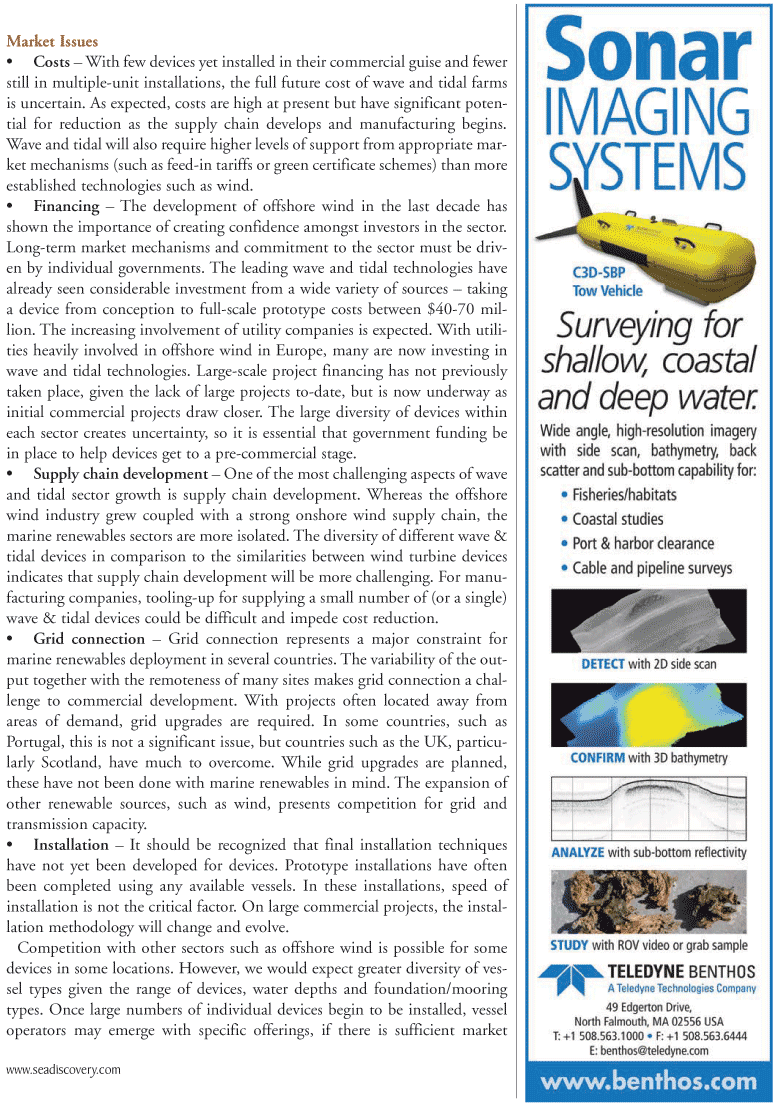
Page 25: of Marine Technology Magazine (June 2011)
Hydrographic Survey
Read this page in Pdf, Flash or Html5 edition of June 2011 Marine Technology Magazine
www.seadiscovery.com
Market Issues • Costs – With few devices yet installed in their commercial guise and fewer still in multiple-unit installations, the full future cost of wave and tidal farms is uncertain. As expected, costs are high at present but have significant poten- tial for reduction as the supply chain develops and manufacturing begins.
Wave and tidal will also require higher levels of support from appropriate mar- ket mechanisms (such as feed-in tariffs or green certificate schemes) than more established technologies such as wind. • Financing – The development of offshore wind in the last decade has shown the importance of creating confidence amongst investors in the sector.
Long-term market mechanisms and commitment to the sector must be driv- en by individual governments. The leading wave and tidal technologies have already seen considerable investment from a wide variety of sources – taking a device from conception to full-scale prototype costs between $40-70 mil- lion. The increasing involvement of utility companies is expected. With utili- ties heavily involved in offshore wind in Europe, many are now investing in wave and tidal technologies. Large-scale project financing has not previously taken place, given the lack of large projects to-date, but is now underway as initial commercial projects draw closer. The large diversity of devices within each sector creates uncertainty, so it is essential that government funding be in place to help devices get to a pre-commercial stage. • Supply chain development – One of the most challenging aspects of wave and tidal sector growth is supply chain development. Whereas the offshore wind industry grew coupled with a strong onshore wind supply chain, the marine renewables sectors are more isolated. The diversity of different wave & tidal devices in comparison to the similarities between wind turbine devices indicates that supply chain development will be more challenging. For manu- facturing companies, tooling-up for supplying a small number of (or a single) wave & tidal devices could be difficult and impede cost reduction. • Grid connection – Grid connection represents a major constraint for marine renewables deployment in several countries. The variability of the out- put together with the remoteness of many sites makes grid connection a chal- lenge to commercial development. With projects often located away from areas of demand, grid upgrades are required. In some countries, such as
Portugal, this is not a significant issue, but countries such as the UK, particu- larly Scotland, have much to overcome. While grid upgrades are planned, these have not been done with marine renewables in mind. The expansion of other renewable sources, such as wind, presents competition for grid and transmission capacity. • Installation – It should be recognized that final installation techniques have not yet been developed for devices. Prototype installations have often been completed using any available vessels. In these installations, speed of installation is not the critical factor. On large commercial projects, the instal- lation methodology will change and evolve.
Competition with other sectors such as offshore wind is possible for some devices in some locations. However, we would expect greater diversity of ves- sel types given the range of devices, water depths and foundation/mooring types. Once large numbers of individual devices begin to be installed, vessel operators may emerge with specific offerings, if there is sufficient market

 24
24

 26
26
